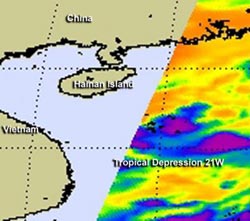NASA observes another tropical depression birth in northwestern Pacific

Infrared imagery from the AIRS instrument aboard NASA's Aqua satellite captured this image of Tropical Depression 21W as a developing low pressure area on Sept. 30. The purple areas indicate the most powerful thunderstorms with coldest cloud top temperatures.<br><br>Credit: NASA/JPL, Ed Olsen<br>
On Monday, Oct. 1 at 1500 UTC (11 a.m. EDT), Tropical Depression 21W (TD21W) had maximum sustained winds near 25 knots. It was centered about300 nautical miles south of Hong Kong, near 17.4 North latitude and 114.8 East longitude. TD21W has tracked northward at 5 knots and is expected to curve to the northwest and west.
On Oct. 1, 2012, infrared imagery from the Atmospheric Infrared Sounder (AIRS) instrument aboard NASA's Aqua satellite shows that the center of circulation is well-defined and the strongest thunderstorms are building in the southeastern quadrant of the storm and wrapping into the center.
The system has been quasi-stationary over the past 12 hours, because it is in a weak steering environment with nothing to push the storm in any direction.
Forecasters at the Joint Typhoon Warning Center expect that Tropical Depression 21W will start moving to the west and approach the central Vietnam coast by Oct. 6 or Oct. 7.
Media Contact
More Information:
http://www.nasa.govAll latest news from the category: Earth Sciences
Earth Sciences (also referred to as Geosciences), which deals with basic issues surrounding our planet, plays a vital role in the area of energy and raw materials supply.
Earth Sciences comprises subjects such as geology, geography, geological informatics, paleontology, mineralogy, petrography, crystallography, geophysics, geodesy, glaciology, cartography, photogrammetry, meteorology and seismology, early-warning systems, earthquake research and polar research.
Newest articles

Properties of new materials for microchips
… can now be measured well. Reseachers of Delft University of Technology demonstrated measuring performance properties of ultrathin silicon membranes. Making ever smaller and more powerful chips requires new ultrathin…

Floating solar’s potential
… to support sustainable development by addressing climate, water, and energy goals holistically. A new study published this week in Nature Energy raises the potential for floating solar photovoltaics (FPV)…

Skyrmions move at record speeds
… a step towards the computing of the future. An international research team led by scientists from the CNRS1 has discovered that the magnetic nanobubbles2 known as skyrmions can be…




















